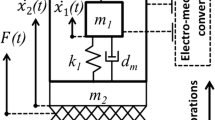Abstract
This paper deals with optimization studies based on artificial intelligence methods. These modern optimization methods can be very useful for design improving of an electromagnetic vibration energy harvester. The vibration energy harvester is a complex mechatronic device which harvests electrical energy from ambient mechanical vibrations. The harvester design consists of a precise mechanical resonator, electromagnetic converter and electronics. The optimization study of such complex mechatronic device is complicated however artificial intelligence methods can be used for set up of optimal harvester parameters. Used optimization strategies are applied to optimize the design of the electro-magnetic vibration energy harvester according to multi-objective fitness functions. Optimization results of the harvester are summarized in this paper. Presented optimization algorithms can be used for a design of new energy harvesting systems or for improving on existing energy harvesting systems.











Similar content being viewed by others
References
Alkhatib R, Jazar GN, Golnaraghi MF (2004) Optimal design of passive linear suspension using genetic algorithm. J Sound Vib 275:665–691. doi:10.1016/j.jsv.2003.07.007
Baekho H, Ho SL, Wooseong K (2007) Optimization of 3.5-in. HDD spindle motors for OP-vibration performance: theoretical prediction and experimental verification. Microsyst Technol 13(8–10):759–766. doi:10.1007/s00542-006-0270-4
Benasciutti D, Moro L, Zelenika S, Brusa E (2010) Vibration energy scavenging via piezoelectric bimorphs of optimized shapes. Microsyst Technol 16(5):657–668. doi:10.1007/s00542-009-1000-5
Buren T, Troster G (2007) Design and optimization of a linear vibration-driven electromagnetic micro-power generator. Sensors and Actuators A 135(2):765–775. doi:10.1016/j.sna.2006.08.009
Chao PCP, Wu SC (2007) Optimal design of magnetic zooming mechanism used in cameras of mobile phones via genetic algorithm. IEEE Trans Magn 43(6):2579–2581. doi:10.1109/TMAG.2007.893317
Chiu CW, Chao PCP, Wu DY (2007) Optimal design of magnetically actuated optical image stabilizer mechanism for cameras in mobile phones via genetic algorithm. IEEE Trans Magn 43(6):2582–2584. doi:10.1109/TMAG.2007.893320
Christophe S et al (2008) Design and implementation of mechanical resonators for optimized inertial electromagnetic microgenerators. Microsyst Technol 14(4–5):653–658. doi:10.1007/s00542-007-0494-y
Duan Y, Harley RG, Habetler TGA (2009) Useful multi-objective optimization design method for PM motors considering nonlinear material properties. Energy Conversion Congress and Exposition 187–193. doi: 10.1109/ECCE.2009.5316144
Engesser M, Franke AR, Maute M, Meisel DC, Korvink J (2010) A robust and flexible optimization technique for efficient shrinking of MEMS accelerometers. Microsyst Technol 16(4):647–654. doi:10.1007/s00542-009-0973-4
Hadas Z, Singule V, Ondrusek C, Kluge M (2007) Simulation of Vibration Power Generator. Recent Advances in Mechatronics 245–250. doi: 10.1007/978-3-540-73956-2_69
Hadas Z, Ondrusek C, Singule V, Kluge M (2008a) Vibration Power Generator for Aeronautics Applications. In: Proceedings of the 10th Anniversary international conference of the EUSPEN, vol I Zurich, pp 46–50
Hadas Z, Zouhar J, Singule V, Ondrusek C (2008b) Design of Energy Harvesting Generator Base on Rapid Prototyping Parts. In: proceedings of IEEE 13th Power Electronics and Motion Control Conference Poznan: 1665–1669. doi: 10.1109/EPEPEMC.2008.4635506
Hadas Z, Ondrusek C, Kurfurst J (2009) Optimization of vibration power generator parameters using self-organizing migrating algorithm. Recent Advances in Mechatronics 2008–2009. Springer-Verlag, Berlin, pp 245–250. doi: 10.1007/978-3-642-05022-0_42
Hadas Z, Ondrusek C, Singule V (2010a) Power sensitivity of vibration energy harvester. Microsyst Technol 16(5):691–702. doi:10.1007/s00542-010-1046-4
Hadas Z, Singule V, Ondusek C (2010b) Verification of vibration power generator model for prediction of harvested power. Solid State Phenom 164:291–296. doi:10.4028/www.scientific.net/SSP.164.291
Hadas Z, Singule V, Vechet S, Ondrusek C (2010c) Development of energy harvesting sources for remote applications as mechatronic systems. In: proceedings of 14th International Power Electronics and Motion Control Conference (EPE/PEMC 2010): 13–19. doi: 10.1109/EPEPEMC.2010.5606867
Messine F, Nogarede B, Lagouanelle JL (1998) Optimal Design of Electromechanical Actuators: A New Method Based on Global Optimization. IEEE Trans Magn 34(1):299–308. doi:10.1109/20.650361
Onwubolu GC, Babu BV (2004) New Optimization Techniques in Engineering (Studies in Fuzziness and Soft Computing), vol 141, Springer–Verlag, Berlin
Paradiso JA, Starner T (2005) Energy Scavenging for Mobile and Wireless Electronic. IEEE Pervasive Comput 4(1):18–27. doi:10.1109/MPRV.2005.9
Priya S, Inman DJ (2009) Energy Harvesting Technologies. Springer, US
Serre C, Pérez-Rodríguez A, Fondevilla N, Martincic E, Morante JR, Esteve J (2009) Linear and non-linear behavior of mechanical resonators for optimized inertial electromagnetic microgenerators. Microsyst Technol 15(8):1217–1223. doi:10.1007/s00542-009-0825-2
Singiresu SR (2009) Engineering Optimization: Theory and Practice. John Wiley, Hoboken
Skaar SE, Nilsen R (2004) Genetic optimization of electric machines, a state of the art study. NORPIE 2004 NTNU, Trondheim–Norway
Song MG, Kim YK, Park NC, Yoo J, Park YP, Onagi N, Akanuma G (2009) Design of moving magnet type pickup actuator using inserted coil. Microsyst Technol 15(10–11):1719–1728. doi:10.1007/s00542-009-0874-6
Spreemann D, Hoffmann D, Folkmer B, Manoli Y (2008) Numerical optimization approach for resonant electromagnetic vibration transducer designed for random vibration. J Micromech Microeng 18(10):1–10. doi:10.1088/0960-1317/18/10/104001
Williams CB, Yates RB (1996) Analysis of a micro-electric generator for microsystems. Sensors and Actuators A52(1):8–11. doi:10.1016/0924-4247(96)80118-X
Zelinka I (2004) SOMA—Self-Organizing Migrating Algorithm. In: Onwubolu GC, Babu BV (eds) New optimization techniques in engineering (studies in fuzziness and soft computing), vol 141. Springer–Verlag, Berlin
Acknowledgments
The present work has been supported by European Regional Development Fund in the framework of the research project NETME Centre under the Operational Programme Research and Development for Innovation. Reg. Nr. CZ.1.05/2.1.00/01.0002, id code: ED0002/01/01, project name: NETME Centre–New Technologies for Mechanical Engineering.
Author information
Authors and Affiliations
Corresponding author
Rights and permissions
About this article
Cite this article
Hadas, Z., Kurfurst, J., Ondrusek, C. et al. Artificial intelligence based optimization for vibration energy harvesting applications. Microsyst Technol 18, 1003–1014 (2012). https://doi.org/10.1007/s00542-012-1432-1
Received:
Accepted:
Published:
Issue Date:
DOI: https://doi.org/10.1007/s00542-012-1432-1




